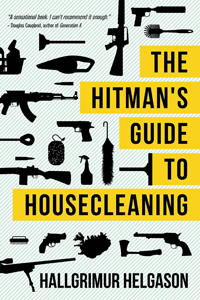Reviewing Hallgrimur Helgason’s “The Hitman’s Guide to Housecleaning”
Tomislav Bokšić is a Croatian career man, and his career is killing. Nicknamed Toxic, this hitman is really good at what he does. Toxic has over 60 hits under his belt, and estimates at having killed 60 soldiers or so during the Bosnian/Serbian wars in which he served, bringing his body count to over 120. This is the man we are introduced to in Hallgrimur Helgason’s The Hitman’s Guide to Housecleaning and Toxic is immediately endearing in a way that you want to resist, but simply cannot.
The Hitman’s Guide was first published in Iceland in 2008, and is Helgason’s only work written in English. The book became an international bestseller in 2009, topping sales in Germany and Iceland, but remained unnoticed in the United States. Despite efforts aimed for US publication and despite being originally written in English, The Hitman’s Guide was unpublished until Amazon decided that if no other US publisher would pick it up, they would. Amazon Crossing published Helgason’s novel in January, 2012, and while it is not topping any lists, it has experienced a small amount of critical attention, and is in the process of being optioned for film.
Where Helgason excels in The Hitman’s Guide is in the delicate balance he creates between humor and a biting social commentary—Toxic, as the narrative voice, is hilarious, as is the author’s imagination. Toxic is introduced to us in the midst of his hitman career, and has just been hired to hit an FBI agent. He makes a rare mistake though, and instead of an FBI agent, Toxic kills a priest in an airport bathroom, and as any good hitman on the lamb would do, he assumes the priest’s identity. Toxic is now Father Friendly, and he will be flying to Iceland to stay with an ultra-Christian fundamentalist host family.
I attempt to enter this strange land like a regular visitor, trying hard to walk like the man I killed last night, swinging his black briefcase like a happy priest, wearing his all-black shoes, shirt, jacket, and coat plus the white collar. I kept the jeans on. I’m a modern minister.
Ironically action packed in spirit and piously reformed (kind of) in action, The Hitman’s Guide successfully toes the line between a schizophrenic thriller and a heartwarming story of redemption, which is what makes this novel and Toxic so endearing. Helgason manages to balance the extremely violent mentality of a mafia hitman with the piety of the Father Friendly, and of his host family, and at this point, “I want to run outside and laugh myself to death. There is nothing funnier than a holy man doing illegal things.”
Toxic’s humanity surfaces gradually throughout the novel, and with it, a conscience. He decides that he has surpassed the number of kills one person can make, without feeling guilty. And killing a holy man was the catalyst for the emergence of Toxic’s conscience, as he feels a slight responsibility to fill Father Friendly’s place in the world. Toxic quickly realizes too that he might have feelings for his host family’s wayward daughter—Gunhildur (who he lovingly calls his “smoking gun” in a land where his beloved guns and violence are non-existent), and we realize that Toxic may also be worth falling for. Sparks fly between the two until heads fly. We learn that Toxic’s girlfriend in New York has been killed—her head is waiting for him in his refrigerator, which devastates the hitman. Toxic becomes a man whose complexities only unfold to reveal more complexity. A callous killer without regret becomes a man with whom we feel connected.
Not only that, but Toxic makes it clear that he is not a cold-blooded killer. He makes a special distinction between wartime kills, and his professional hits, neither of which does he feels bad about. For him, killing was, in essence, doing God’s work. He was ridding society of fundamentally bad people (that is, until the priest). Through his relationship with Gun (admittedly rocky after the girlfriend’s-head-in-the-fridge episode), Toxic reveals himself to be a man of intricate morality, who possesses mostly lovable qualities—tainted only by one, really big downfall. My mother would call Toxic’s past a “red flag”, but Gun sees through it to the man who is capable of incredible love and transformation. With the help of the Icelandic Christian community, some fight-club-esque beatings, and a stringent fasting regimen, Toxic is purged of his killer tendencies, but maintains his autonomy.
It is in Toxic’s ultimate reconciliation between his past life and the extreme piety of his hosts in Iceland that Helgason manages to critique the polarization that has emerged, especially, in our contemporary American society. While Helgason wrote before we experienced Sandy Hook and the subsequent gun control Chinese finger trap, and before the Boston bombing, and before the issue of gay marriage grew to the behemoth it is now, The Hitman’s Guide to Housecleaning comments expertly on the futility of extreme, polarized positions. We are asked questions that challenge polarizing beliefs: “You think the killer doesn’t care about life? You think he doesn’t care about health or keeping a clean house?” For this reason, Helgason’s novel is an important addition to American bookshelves, and for the Helgason’s style and unique voice, this novel is truly a joy to read.
Alyssa Fechner


